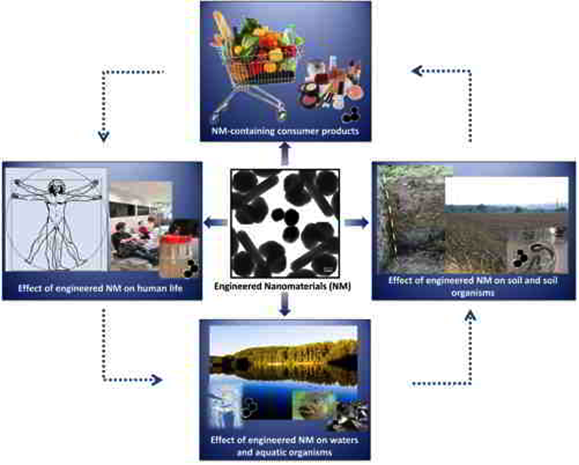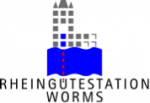
NanoUmwelt – Risk analysis of engineered nanomaterials in the environment: identification, quantification and analysis of the human- and ecotoxicological effects
Aim of the project NanoUmwelt was to quantify the entry of engineered nanomaterials into various environmental compartments, to characterise their form of appearance and to develop a deeper understanding of their eco- and human-toxicological impact using novel analytical methodologies and scientifically sound analyses. The data generated within NanoUmwelt shall serve as a reliable basis for a realistic risk assessment of nanomaterials after their entry into the environment and for the development of appropriate recommendations for novel regulations with regard to the protection of human life and the environment.

NanoUmwelt Projectplan
Against this background, NanoUmwelt had dealt with three different tasks:
- the detection and quantification of smallest amounts of nanomaterials (<ng/L or <ng/kg) in environmental and human samples
- the in vitro investigation of the human- and ecotoxicity in the low-dose range
- the standardised and reproducible synthesis of nanomaterials
The most important developments within NanoUmwelt are:
- A standardised sample preparation protocol for the analysis of engineered nanomaterials in complex human and environmental samples such as human blood, fish tissues and mussels
- Powerful analytical methodologies based on Transmission Electron Microscopy (TEM), Immunoassays (ABICAP) and Asymmetrical Flow Field-Flow Fractionation (AF4) for the quantification and characterization of engineered nanomaterials in complex human- and environmental samples down to trace levels (<µg/L)
- Novel in vitro– and ex vivo-models for the investigation of human-toxicological effects of nanomaterials based on endpoints like cardiotoxicity, immune reaction, differentiation potential and transport across biological barriers
- Novel model systems for the investigation of ecotoxicological effects of nanomaterials
The most important findings of NanoUmwelt are:
- The concentrations of engineered nanomaterials in all investigated real samples were below the limits of quantification of the analytical methodologies developed within NanoUmwelt
- A long-term exposure of silver (AgPure) and polystyrene nanoparticles in soil has significant impact on soil microbial and enzyme activities as well as the functional diversity of the soil microbial community (https://doi.org/10.1016/j.jes.2018.04.013; https://doi.org/10.1186/s12302-018-0140-6)
- Uptake of polystyrene nanoparticles into human cells could be observed, however, no influence on the cell viability was evident in the low-dose range
- No conclusive statement on the permeability of biological barriers for engineered nanomaterials can be drawn, yet
- Model systems of the intestinal and placental barrier represent very suitable tools for the investigation of the transport of nanomaterials in the human organism. The selection of the respective model (2D-in vitro, 3D-in vitro or ex vivo) is crucial with regard to the results of the performed studies. It could be demonstrated that, depending on the applied model system, nanoparticles can partially induce different effects. Hence, the proper choice of the applied model system is a very critical parameter in human toxicology
Grant Number: BMBF - FKZ 03X0150
Duration: 01.10.2014 - 31.12.2017
Project Lead

Dr. Florian Meier, Postnova Analytics GmbH
Project Partners

Postnova Analytics GmbH, Landsberg am Lech (DE)
Fraunhofer-Institute for Biomedical Engineering (IBMT) (DE)

Fraunhofer Institute for Molecular Biology and Applied Ecology (IME) (DE)
Senova mbH, Weimar (DE)

Institute for Molecular Bio Science - Plant Cell Physiology, Goethe University Frankfurt am Main (DE)

Faculty IV - Geography/Geosciences, Department of Soil Science, University Trier, Trier (DE)

Umweltbundesamt (UBA), Berlin (DE)

PlasmaChem GmbH, Berlin (DE)

Rheinguetestation Worms, Worms (DE)
Subcontractor

Particles-Biology Interactions Lab, Empa - Swiss Federal Laboratories for Materials Science and Technology, St. Gallen (CH)

Research Centre of Medical Technology and Biotechnology, fzmb GmbH, Bad Langensalza (DE)
Publications
2018
- Aengenheister L., Keevend K., Muoth C., Schonenberger R., Diener L., Wick P., Buerki-Thurnherr T. (2018). An advanced human in vitro co-culture model for translocation studies across the placental barrier. Sci Rep, 8(1): 5388.
- Awet T.T., Kohl Y., Meier F., Straskraba S., Grun A.L., Ruf T., Jost C., Drexel R., Tunc E., Emmerling C. (2018). Effects of polystyrene nanoparticles on the microbiota and functional diversity of enzymes in soil. Environ Sci Eur, 30(1): 11.
- Grun A.L., Straskraba S., Schulz S., Schloter M., Emmerling C. (2018). Long-term effects of environmentally relevant concentrations of silver nanoparticles on microbial biomass, enzyme activity, and functional genes involved in the nitrogen cycle of loamy soil. J Environ Sci (China), 69 12-22.
2016
- Kohl, Y. (2016). Kleinstmengen von Nanomaterialien in Umweltproben nachweisen. Gefahrstoffe-Reinhaltung der Luft, Springer-Verlag, Ausgabe 06/2016, S. 201-202.
- Kohl, Yvonne (23.06.2016). Nanomaterialien in Umweltproben - Sensitive Methode zum Nachweis im ppb-Bereicht. GIT Labor-Portale für Science & Industry, Fachzeitschrift 08/2016.
- Kohl Y. (2016). Nanomaterials in Environmental Samples - Sensitive Method for the Detection in the ppb-Range. GIT - Laborfachzeitschrift, 11-12/2016 32-34.
- Meier F., Kohl Y. (2016). Spurensuche im Fluss. Nachr. Chem., 64(12): 1168-1171.
- Muoth C., Aengenheister L., Kucki M., Wick P., Buerki-Thurnherr T. (2016). Nanoparticle transport across the placental barrier: pushing the field forward! Nanomedicine (Lond), 11(8): 941-957.
- NanoUmwelt Konsortium (2016). Detektor für Nanoteilchen. Technology Review 06/2016, S.18.
Alle verfügbaren Abschlussberichte des NanoUmwelt Konsortiums finden Sie auf den Seiten der TIB Hannover https://www.tib.eu/de/
- Postnova Analytics GmbH (2018). NanoUmwelt - Risikoanalyse synthetischer Nanomaterialien in der Umwelt: Identifizierung, Quantifizierung und Untersuchung der human- und ökotoxikologischen Effekte : Teilprojekt : Veröffentlichung der Ergebnisse von Forschungsvorhaben im BMBF-Programm : Projektlaufzeit: 01.10.2014-31.12.2018. FKZ 03X0150A. TIB Hannover. (DOI)
- Fraunhofer-Institut für Biomedizinische Technik IBMT
- Universität Trier
- Senova Gesellschaft für Biowissenschaft und Technik mbH (2018). NanoUmwelt - Risikoanalyse synthetischer Nanomaterialien in der Umwelt: Identifizierung, Quantifizierung und Untersuchung der human- und ökotoxikologischen Effekte : Teilprojekt: Anreicherung und Nachweis von Nanopartikeln mit 3-dimensionaler Immunofiltration : Veröffentlichung der Ergebnisse von Forschungsvorhaben im BMBF-Programm : Projektlaufzeit: 01.10.2014-30.09.2017. FKZ 03X0150E, TIB Hannover. (DOI)
- Johann Wolfgang Goethe-Universität Frankfurt am Main, Institut für Molekulare Biowissenschaften (2018). NanoUmwelt - Risikoanalyse synthetischer Nanomaterialien in der Umwelt: Identifizierung, Quantifizierung und Untersuchung der human- und ökotoxikologischen Effekte : Teilprojekt "Elektronenmikroskopische Analyse von Nanomaterialien in Umwelt- sowie humanen Proben" : Veröffentlichung der Ergebnisse von Forschungsvorhaben im BMBF-Programm : Projektlaufzeit: 01.10.2014-31.12.2017. FKZ 03X0150F, TIB Hannover. (DOI)
- PlasmaChem GmbH (2018). NanoUmwelt - Risikoanalyse synthetischer Nanomaterialien in der Umwelt: Identifizierung, Quantifizierung und Untersuchung der human- und ökotoxikologischen Effekte : Veröffentlichung der Ergebnisse von Forschungsvorhaben im BMBF-Programm : Teilprojekt PlasmaChem GmbH, Berlin : Projektlaufzeit: 01.10.2014-30.09.2017. FKZ 03X0150G, TIB Hannover. (DOI)
2018
- Meier F., Axtner T., Drexel R., Klein T. (2018). Asymmetrical Flow Field-Flow Fractionation for Trace Level Analysis of Engineered Silver Nanomaterials in River Water, 19th International Symposium on Field- and Flow-Based Separations (FFF2018), 14.-17. Mai 2018, Columbia, South Carolina, USA. [Poster]
- Meier F. (2018). Asymmetrical Flow Field-Flow Fractionation hyphenated with ICP-MS – A promising Tool for Trace Analysis of Engineered Silver Nanomaterials in Environmental Samples, ESAS & CANAS Konferenz 2018, 20.-23. März, Bundesanstalt für Materialforschung und -prüfung (BAM), Berlin, Deutschland. [Vortrag]
- Buerki-Thurnherr T. (2018). Nanoparticles-biobarriers interactions: impact of particle properties on barrier penetration and functionality, Focus event 9th VERT Forum, 16. Februar 2018. Empa, Dübendorf, Schweiz. [Vortrag]
- Meier F., Axtner T., Drexel R., Klein T. (2018). Asymmetrical Flow Field-Flow Fractionation for Trace Level Analysis of Engineered Silver Nanomaterials in River Water, WCPS 2018, 08.-13. Januar 2018, Amelia Island, Florida, USA. [Poster]
2017
- Hesler M., Straskraba S., Meier F., Kohl Y. (2017). Are nanoparticles harmful to the intestinal barrier? Dose-, size- and functionalization-dependent effects in vitro and ex vivo, Nanosafety 2017, 11.-13. Oktober, Saarbrücken, Deutschland. [Poster]
- Meier F. (2017). NanoUmwelt - Risk analysis of engineered nanomaterials in the environment: identification, quantification and analysis of the human- and ecotoxicological effects, Scientific Stakeholder Meeting on Nanomaterials in the Environment, 10.-11. Oktober 2017, Umweltbundesamt, Dessau, Deutschland. [Vortrag]
- NanoUmwelt Konsortium (2017). Risk assessment of nanomaterials in the environment, 4th International Conference on Environmental Specimen Banks, 02. -04. Oktober 2017, Bilbao, Spain. [Poster]
- Meier F., Axtner T., Drexel R., Klein T. (2017). Asymmetrical Flow Field-Flow Fractionation for Trace Level Analysis of Engineered Silver Nanomaterials in River Water, 4th FFF-ICP-MS Workshop 2017, 28.-29. September 2017, Wien, Österreich. [Poster]
- Hesler M., Meier F., Straskraba S., Kohl Y. (2017). Do nanoparticles pass the intestinal barrier? Transport studies in vitro and ex vivo, Eurotox 2017 53rd Congress of the European Societies of Toxicology, 10.-13. September 2017, Bratislava, Slowakei. [Poster]
- Komo P., Straskraba S., Kohl Y. (2017). Do nanoparticles affect the human stem cell differentiation?, Eurotox 2017 53rd Congress of the European Societies of Toxicology, 10.-13. September 2017, Bratislava, Slowakei. [Poster]
- Clarke P., Meier F., Axtner T., Drexel R., Klein T. (2017). Asymmetrical Flow Field-Flow Fractionation for Trace Level Analysis of Engineered Silver Nanomaterials in River Water, ICEENN 2017, 03.-08. September 2017, Birmingham, UK. [Poster]
- Grün, A.-L.;Straskraba, S.; Kohl, Y.; Meier, F.; Schloter, M.; Emmerling, C. (2017). Effekte von umweltrelevanten Konzentrationen von Silbernanomaterialien auf die Struktur und Funktion der mikrobiellen Bodengemeinschaft. Jahrestagung der Deutschen Bodenkundlichen Gesellschaft 2017, 03.-07.September 2017, Göttingen, Deutschland. [Vortrag]
- Meier F., Axtner T., Drexel R., Klein T. (2017). Asymmetrical Flow Field-Flow Fractionation for Trace Level Analysis of Engineered Silver Nanomaterials in River Water, Wasser 2017, 22.-24. Mai, Donaueschingen, Deutschland. [Poster]
- Kohl Y., Meier F. (2017). NanoUmwelt: Risikoanalyse synthetischer Nanomaterialien in der Umwelt, Clustertreffen NanoCare, 04.-05. Mai 2017, KIT Karlsruhe, Deutschland. [Vortrag]
- Komo P., Straskraba S., Kohl Y. (2017). Do nanoparticles affect the human stem cell differentiation?, Clustertreffen NanoCare, 04.-05. Mai 2017, KIT Karlsruhe, Deutschland. [Poster]
- Hesler M., Meier F., Straskraba S., Kohl Y. (2017). Transport studies of polystyrene nanoparticles across the intestinal barrier in vitro and ex vivo, Clustertreffen NanoCare, 04.-05. Mai 2017, KIT Karlsruhe, Deutschland. [Poster]
- Meier F., Axtner T., Drexel R., Klein T. (2017). Asymmetrical Flow Field-Flow Fractionation for Trace Level Analysis of Engineered Silver Nanomaterials in River Water, Clustertreffen NanoCare, 04.-05. Mai 2017, KIT Karlsruhe, Deutschland. [Poster]
- Meier F. (2017). Asymmetrical Flow Field-Flow Fractionation hyphenated with ICP-MS – A promising Tool for Trace Analysis of Engineered Silver Nanomaterials in Environmental Samples, Anakon 2017, 03.-06. April 2017. Tübingen, Deutschland. [Vortrag]
- Meier F. (2017). Asymmetrical Flow Field-Flow Fractionation hyphenated with ICP-MS – A promising Tool for Trace Analysis of Engineered Silver Nanomaterials in Environmental Samples, NanoImpact 2017, 12.-17. März 2017, Monte Verita, Schweiz. [Vortrag]
2016
- Kohl Y. (2016). Nanomaterialien: Toxikologische Bewertung und medizinische Anwendung. Informations-und Netzwerkveranstaltung der Deutschen Plattform NanoBioMedizin, 12. Dezember 2016, Frankfurt, Deutschland. [Vortrag]
- Aengenheister L., Schönenberger R., Manser P., Muoth C., Wick P., Buerki-Thurnherr T. (2016). Improving nanoparticle translocation studies at the placental barrier – an advanced in vitro model. Empa PhD-Symposium, 14. November 2016, Dübendorf, Schweiz. [Vortrag]
- Buerki-Thurnherr T., Grafmueller S., Manser P., Muoth C., Aengenheister L., Wichser A., Jochum W., Diener P. A., von Mandach U., Wick P. (2016). Towards an improved understanding of nanoparticle-placenta interactions using human ex vivo and advanced in vitro models. TEDD meeting, 27. Oktober 2016 Wädenswil, Schweiz. [Poster]
- Meier F., Drexel R., Pfaffe T., Moldenhauer E., Reed R. B., Tadjiki S., Klein T. (2016). Hyphenation of AF4 and ICP-MS for trace level analysis of engineered silver nanomaterials in environmental samples - How low can we go? 4th FFF-Workshop, 29.-30. September 2016, Wien, Österreich. [eingeladener Vortrag]
- Meier F., Drexel R., Pfaffe T., Moldenhauer E., Klein T. (2016). Application of Field Flow Fractionation hyphenated with UV, DLS and ICP-MS for the determination of engineered silver nanoparticles in environmental samples down to trace levels. 25. ICP-MS Anwendertreffen, 12.-15. September 2016, Siegen, Deutschland. [Vortrag]
- NanoUmwelt Konsortium (2016). NanoUmwelt: STATUS REPORT AFTER 18 MONTH: Risk analysis of engineered nanomaterials in the environment. Nano meets Future, 15.-16. September 2016, Saarbrücken, Deutschland. [Poster]
- Buerki-Thurnherr T., Muoth C., Aengenheister L., Kucki M., Manser P., Diener L., Wichser A., Schönenberger R., Jochum W., Wick P. (2016). Establishment of novel advanced in vitro models of the human placental barrier for nanoparticle translocation and effect studies. 44th Annual Conference of the European Teratology Society, 11.-14. September 2016, Dublin, Irland. [Vortrag]
- Kohl Y. (2016). On the track of nanomaterials: Risk assessment of nanomaterials in the environment. Biologisches Kolloquium der Universität Siegen, 13. Juli 2016, Siegen, Deutschland. [Vortrag]
- Kohl Y. (2016). Nanomaterials: All-rounder or environmental hazard? GDCh-Vortrag an der Technischen Universität Kaiserslautern, 4. Juli 2016, Kaiserslautern, Deutschland. [Vortrag]
- Buerki-Thurnherr T., Grafmueller S., Manser P., Muoth C. , Aengenheister L., Wichser A., Jochum W., Diener PA., U. von Mandach, Wick P. (2016). Study-ing nanoparticle translocation and effects at the human placental barrier using ex vivo and advanced in vitro model systems. Clinical Nanomedicine and Targeted Medicine (CLINAM), 26.-29. Juni 2016, Basel, Schweiz. [Poster]
- Aengenheister L., Muoth C., Wichser A., Schönenberger R., Manser P., Wick P., Buerki-Thurnherr T. (2016). Establishment of an advanced in vitro model to study translocation of nanoparticles across the human placenta. 9th EPPW, 14.-15. Juni 2016, Graz, Österreich [Poster]
- Meier F., Grün A.L., Emmerling C., Antipov A., Straskraba S., Schmidt M., Büchel C., Diehl P., Kohl Y., Klein T. (2016). Towards Trace Level Analysis of Silver Nanoparticles in Environmental Samples using Asymmetrical Flow Field-Flow Fractionation coupled with UV, DLS and ICP-MS. FFF Symposium, 22.-27. Mai 2016, Dresden, Deutschland. [Poster]
- Grün A.L., Emmerling C. (2016). Effects of environmental relevant concentrations of silver nanomaterials on microorganisms in a loamy soil. Clustertreffen NanoCare, 03.-04. Mai 2016, Frankfurt am Main, Deutschland. [Poster]
- NanoUmwelt Konsortium (2016). NanoUmwelt: STATUS REPORT AFTER 18 MONTH: Risk analysis of engineered nanomaterials in the environment. Clustertreffen NanoCare, 03. -04. Mai 2016, Frankfurt am Main, Deutschland. [Poster]
- Aengenheister L., Schönenberger R., Manser P., Muoth C., Wick P., Buerki-Thurnherr T. (2016). Establishment of a perfused in vitro model of the placental barrier for nanoparticle translocation studies. BioBarriers, 07.-09. März 2016, Saarbrücken, Deutschland. [Vortrag]
- Aengenheister L., Muoth C., Wichser A., Schönenberger R., Manser P., Wick P., Buerki-Thurnherr T. (2016). Establishment of an advanced in vitro model to study translocation of nanoparticles across the human placenta. BioBarriers, 07.-09. März 2016, Saarbrücken, Deutschland. [Poster]
- Buerki-Thurnherr, T. (2016). Plazenta-Barriere: Mit neuen Technologien und Erkenntnissen zu aussagekräftigen humanen Modellen. 9.Tierversuchstagung des Schweizer Tierschutz STS, Ersatzmethoden – wo-hin?, 3. März 2016, Olten, Schweiz. [Vortrag]
- Meier F., Grün A.L., Emmerling C., Antipov A., Straskraba S., Schmidt M., Büchel C., Diehl P., Kohl Y., Klein T. (2016). Towards Trace Level Analysis of AgNPs in Environmental Samples using AF4 coupled with UV, DLS and ICP-MS. HTC-14 - 14th International Symposium on Hyphenated Techniques in Chromatography and Separation Technology, 27.-29. Januar 2016, Gent, Belgien. [Poster]
2015
- Aengenheister L., Muoth C., Wichser A., Schönenberger R., Manser P., Wick P., Buerki-Thurnherr T. (2015). Establishment of an advanced in vitro model to study translocation of nanoparticles across the human placenta. Empa PhD-Symposium, 07. Dezember 2015, Dübendorf, Schweiz. [Poster]
- Buerki-Thurnherr T., Muoth C., Aengenheister L., Kucki M., Manser P., Diener L., Jochum W., Wick P. (2015). Nanoparticles at the human placental bar-rier: Advancing in vitro placenta models using co-cultures and mimicking the 3D and/or dynamic microenvironment. 16th Annual Congress of EUSAAT, 20.-23. September 2015, Linz, Österreich. [Poster]
- Grün A.L., Meier F., Schloter M., Emmerling C. (2015). Effects of environmental relevant concentrations of nanomaterials on soil microorganisms. International Conference on the Environmental Effects of Nanoparticles and Nanomaterials, 6.-10. September 2015, Wien, Österreich. [Poster]
- Grün A.L., Schloter M., Emmerling C. (2015). Effekte von umweltrelevanten Konzentrationen von Nanomaterialien auf Bodenmikroorganismen. Jahrestagung der Deutschen Bodenkundlichen Gesellschaft, 05.-10. September 2015, München, Deutschland. [Vortrag]
- Aengenheister L., Buerki-Thurnherr T., Grafmueller S., Manser P., Muoth C., Wick P. (2015). Studying translocation and effects of nanoparticles at the placental barrier. 8th EPPW, 23.-24. Juni 2015, Bern, Schweiz. [Vortrag]
- Aengenheister L., Ellinger B., Fedutik Y., Gutenberg L.M., Boariu A., Wick P., Buerki-Thurnherr T. (2015). Studying translocation and effects of silver nanoparticles at the placental barrier. Clustertreffen NanoCare, 19. -20. Mai 2015, Frankfurt am Main, Deutschland. [Poster]
- Grün A.L., Ruf T., Meier F., Boariu A., Schmidt M., Emmerling C. (2015). Percolation behaviour of silver nanomaterials in soils. Clustertreffen NanoCare, 19.-20. Mai 2015, Frankfurt am Main, Deutschland. [Poster]
- NanoUmwelt Konsortium (2015). NanoUmwelt: RISK ANALYSIS OF ENGINEERED NANOMATERIALS IN THE ENVIRONMENT. Clustertreffen NanoCare, 19. -20. Mai 2015, Frankfurt am Main, Deutschland. [Poster]
2016
- Projekt NanoUmwelt - »Nano«-Kleinstmengen in Umweltproben nachweisen. Pressemeldung Fraunhofer Forschung (www.ibmt.fraunhofer.de, 28.04.2016)
- Nanomaterialien auf der Spur - Forscher ebnen neue Wege zur realistischen Risikobewertung von Nanomaterialien in der Umwelt, Pressemeldung des NanoUmwelt Konsortium, 18.08.2015 (PDF, 300 KB)
- Präsentation : "Die Rheingütestation Worms - Aufgaben und Arbeitsweise", Dr. Peter Diehl, Rheingütestation Worms im Landesamt für Umwelt, Wasserwirtschaft und Gewerbeaufsicht Rheinland-Pfalz. (PDF; 2.3 MB)
 >
>